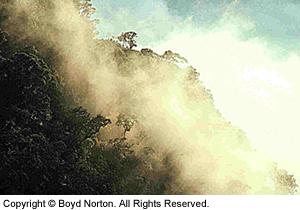
Orangutans lead a far different life style from mountain gorillas. Orangutan habitat is some of the wettest, steamiest rain forest in the world, on the islands of Sumatra and Borneo. In contrast to the social family structure of mountain gorillas, orangutans are loners. And rather than being terrestrial like mountain gorillas, orangutans spend much of their lives in the trees.
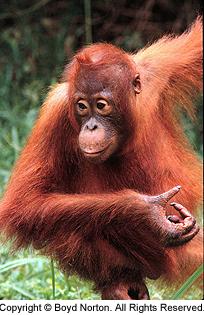
The name Orang-utan comes from two Malay words: Orang, meaning “man” or “people”, and Hutan, “forest.” Thus the name means “People of the forest.” As recently as 1984 the number of wild orangutans was estimated by some sources to be 150,000 or more. There’s question as to whether those estimates are even close to being accurate because of the great difficulty of making a census of such solitary animals living in dense forest. Currently, with more accurate census information, the number of orangutans living in the wild is estimated at 20-27,000 – an alarmingly small number, considering those earlier figures.
Orangutan diet consists primarily of fruit, with leaves, bark, flowers, insects and birds’ eggs being consumed as well. Their habitat ranges from somewhat cooler montane forests to steamy lowland dipterocarp forests. Living in warmer climes requires less fur for warmth than mountain gorillas. And their reddish color makes them very distinctive.
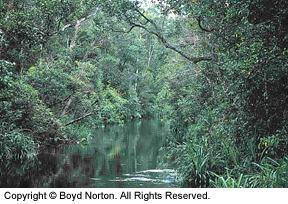
Lowland rain forest, Tanjung Putting National Park, Kalimantan, Indonesian Borneo. This narrow river channel leads through lush forest to Camp Leakey, research center for Birute Galdikas’ studies of orangutans. Relative humidity in these forests must be in the high 90s most of the time when it’s not raining. The amount of biodiversity is amazing. These Borneo rain forests are considered to be the oldest in the world, perhaps predating South American forests by millions of years. The only feasible way of getting around here is by boat, following those navigable channels that penetrate into the interior.
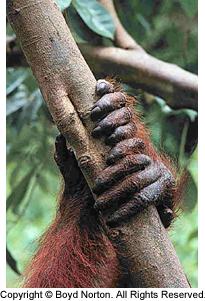
Hands of an adult female orangutan, Tanjung Putting National Park, Kalimantan, Indonesian Borneo. Their long, narrow hands and very long arms make them suitable for their arboreal life. In places such as Camp Leakey in Kalimantan and Sepilok Orangutan Sanctuary in Sabah (Malyasian) Borneo, captive born and young orangs confiscated from the illegal pet trade are being re-introduced into the wild. It’s a long process that can take up to eight years, but there have been many successful re-introductions. And often these newly wild animals will return to feeding stations, along with their truly wild counterparts, to accept fresh fruit put out for them.
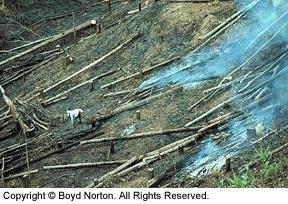
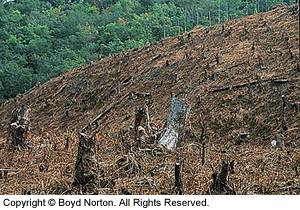
These two pictures show why the orangutans are an endangered species. The loss of their rain forest habitat is appalling. Slash and burn agriculture and commercial logging is destroying their world at such a rate that remaining orangutans are being forced into smaller and smaller domains. Both of these pictures were made in Sabah, Malaysian Borneo. Similar scenes are found all across both Malaysian and Indonesian Borneo and in the parts of Sumatra where orangutans are found.
I have flown over large areas of Borneo that has been denuded of rain forest. And this despite protestations of the government that such practices are being controlled and limited.
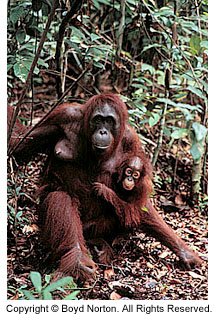
This wild female with a one year old youngster was photographed in Tanjung Putting National Park in Kalimantan, Indonesian Borneo. There is a feeding station in the forest adjacent to Camp Leakey Research Center and a number of wild orangutans come here on occasion to get fresh fruit. Obviously they have become tolerant of people. Most wild orangutans are shy animals and will flee at the sight of humans. At one time they were hunted for “sport” and indigenous people in the past considered them a source of food.
Reproductive rate of orangutans is very small. Each adult female may give birth only once every 8 to 9 years and may have only 3 to 4 offspring in their lifetime. Life expectancy in the wild is not known, but is probably less than 45 to 50 years.
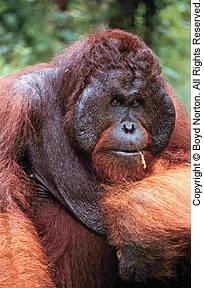
This adult male was photographed in the forest of Tanjung Putting National Park, Kalimantan, Indonesian Borneo. Males like this can weigh up to 220 pounds (about half the weight of a silverback mountain gorilla) and reach a height of 5 feet. Prominent cheek pads are a feature of adult males 20 years or older. Young orangutans stay with or near their mother until maturity, which for females is about 12 to 14 years and for males about 15 years of age.
Most of the orangutan photography you see here was done with the Leica 70-210mm zoom on either an R-8 or R-5 body. I use Leica equipment because it is the most rugged and reliable available. I’ve seen too many other cameras die in this steamy environment. In addition, Leica lenses are the sharpest I’ve ever used.
In rain forest environment the faster films are very helpful; most of these were done using E100S (occasionally pushed one stop) and on E200. A number of times I’ve pushed the E200 one and two stops with superb results – very fine grain, almost no contrast gain, and excellent color saturation.
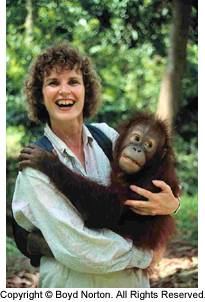
My wife Barbara became good friends with this three year old orangutan at the Sepilok Orangutan Sanctuary in Malaysian Borneo. This rehabilitation center has had a good success rate at re-introducing captive born and confiscated orangutans into the wild. This youngster is now probably living on his own in the wild, with occasional return for some nice fresh fruit. However, his outlook for living his entire lifespan in the wild is not good unless strong effort is made to halt destruction of the rain forest.
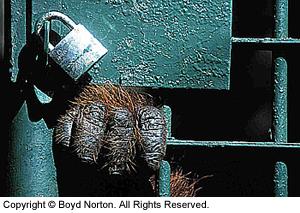
Will this be the fate of all orangutans in the future, a life behind bars in zoos? I sincerely hope not.
by Boyd Norton

Leave a Reply